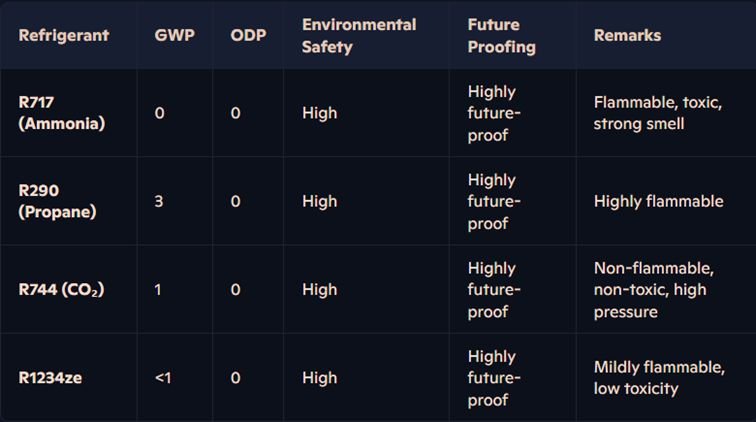Transition to lower GWP refrigerants: Market Trends
𝐈𝐧𝐝𝐮𝐬𝐭𝐫𝐢𝐚𝐥 𝐡𝐞𝐚𝐭 𝐩𝐮𝐦𝐩 𝐬𝐮𝐩𝐩𝐥𝐢𝐞𝐫𝐬 and 𝐎𝐑𝐂 𝐬𝐲𝐬𝐭𝐞𝐦𝐬 𝐭𝐡𝐚𝐭 𝐫𝐞𝐮𝐬𝐞 𝐰𝐚𝐬𝐭𝐞 𝐡𝐞𝐚𝐭 are transitioning to lower GWP refrigerants, driven by market pressure and regulations such as 𝐄𝐮𝐫𝐨𝐩𝐞’𝐬 𝐫𝐞𝐯𝐢𝐬𝐞𝐝 𝐅-𝐠𝐚𝐬 𝐫𝐞𝐠𝐮𝐥𝐚𝐭𝐢𝐨𝐧 (𝐄𝐔 2024/573) that came into effect in March 2024 in addition to future market bans on refrigerants that exceed specified GWP thresholds that vary by product type.
Some of the leading industrial heat pump manufacturers offer a selection of models that use;
• 𝐑717 (𝐍𝐇3, 𝐀𝐦𝐦𝐨𝐧𝐢𝐚 – 𝐞𝐟𝐟𝐢𝐜𝐢𝐞𝐧𝐭 𝐛𝐮𝐭 𝐭𝐨𝐱𝐢𝐜),
• 𝐑290 (𝐏𝐫𝐨𝐩𝐚𝐧𝐞 – 𝐞𝐟𝐟𝐢𝐜𝐢𝐞𝐧𝐭 𝐛𝐮𝐭 𝐡𝐢𝐠𝐡𝐥𝐲 𝐟𝐥𝐚𝐦𝐦𝐚𝐛𝐥𝐞),
• 𝐑744 (𝐂𝐎2),
• 𝐑1234𝐳𝐞 (𝐇𝐅𝐎 – 𝐚 𝐬𝐲𝐧𝐭𝐡𝐞𝐭𝐢𝐜 𝐫𝐞𝐩𝐥𝐚𝐜𝐞𝐦𝐞𝐧𝐭 𝐟𝐨𝐫 𝐑134𝐚)
• 𝐇𝐅𝐂 𝐛𝐚𝐬𝐞𝐝 refrigerants such as 𝐑134𝐚.
Operational considerations when assessing refrigerant suitability include;
• COP,
• Retro-fit capability into existing systems,
• Effectiveness in cold climates,
• Flammability and proximity to sensitive receptors (i.e. apartments and terraced houses)
• The need for specialised equipment (as with CO2 due to higher pressure and lift temperature required).
Looking at a few leading Organic Rankine Cycle system suppliers, 𝐑1233𝐳𝐝𝐄 and 𝐑245𝐟𝐚 are used for their medium temperature products and 𝐇𝐂𝐬 (𝐡𝐲𝐝𝐫𝐨𝐜𝐚𝐫𝐛𝐨𝐧𝐬) for higher temperatures.
• 𝐑1233𝐳𝐝 is classed as an HFO rather than an HFC. HFOs are a newer class of refrigerants designed to have very low GWP and ODP parameters.
• 𝐑245𝐟𝐚 is an HFC. This class was developed as a replacement for ozone-depleting CFCs and HCFCs, but they still have a relatively high GWP compared to newer alternatives like HFOs.
Check out our recent article, "Green Data Centers: Heat Reuse Options Every Facility Engineer Should Know" for more details on waste heat reuse opportunties.
https://lnkd.in/dPuKimyw
E: enquiries@biyatenergyenvironment.com
T: +44 121 318 4019
HQ: Regent House, 320a Stratford Rd, Solihull, U.K, B90 3DN
Company No: 10842762

